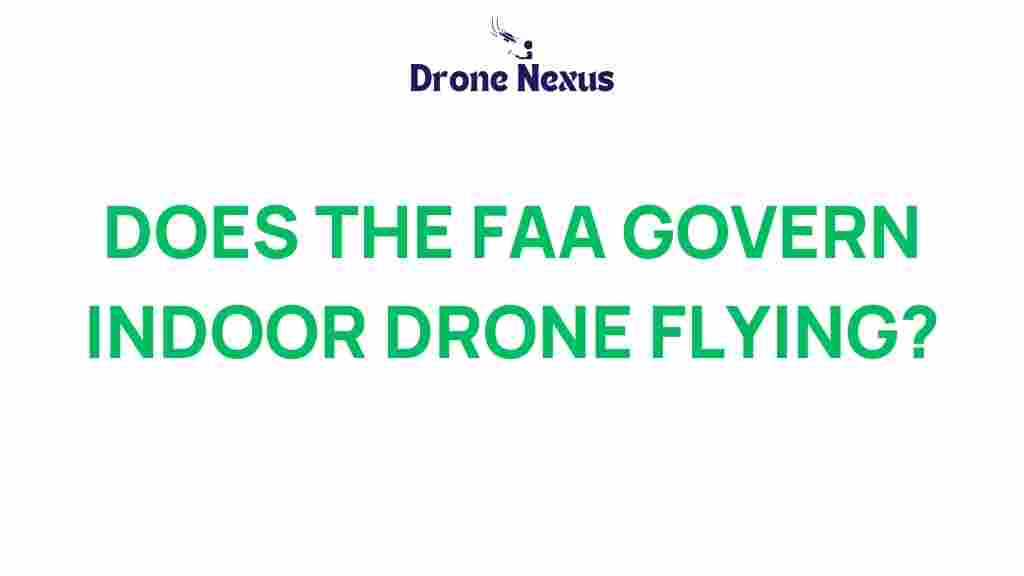Understanding the FAA’s Role in Indoor Drone Flying Regulations
As the popularity of drones continues to rise, understanding the FAA’s role in regulating indoor drone flying becomes increasingly important for hobbyists and professionals alike. The Federal Aviation Administration (FAA) is the primary regulatory body overseeing the use of drones in the United States. While most people associate the FAA with outdoor flying, its influence extends to indoor operations as well. This article will explore the FAA’s regulations, the specific guidelines for indoor drone flying, and how to navigate the complexities of compliance to ensure a safe flying experience.
Why Indoor Drone Flying is Different
Indoor drone flying presents unique challenges and considerations that differ from outdoor operations. Here are a few reasons why:
- Space Constraints: Indoor environments often have limited space, requiring careful maneuvering to avoid obstacles.
- Privacy Concerns: Flying drones indoors raises questions about privacy, especially in residential areas or public venues.
- Safety Regulations: The risks associated with flying drones indoors can vary significantly from outdoor flying, necessitating specific safety measures.
The Role of the FAA
The FAA’s primary role is to ensure the safety and efficiency of the national airspace system. While the agency has established comprehensive guidelines for outdoor drone usage, it has also provided recommendations for indoor use. Understanding these regulations is key for anyone interested in flying drones indoors.
Current FAA Regulations for Indoor Drone Flying
While the FAA does not have specific regulations solely for indoor drone flying, it does provide guidelines that must be considered. Here are the key points to keep in mind:
- Weight Limit: Drones that weigh less than 0.55 pounds (250 grams) do not require FAA registration. However, it’s essential to check local regulations as they may impose additional restrictions.
- Commercial Use: If you plan to use your drone for commercial purposes indoors, you must have a Remote Pilot Certificate.
- Airspace Considerations: The FAA does not regulate indoor airspace, but operators should be aware of any local rules or venue-specific guidelines.
Registration Requirements
For drones weighing more than 0.55 pounds, FAA registration is mandatory even if they are flown indoors. This process is relatively straightforward:
- Visit the FAA’s registration page to start the application process.
- Provide the necessary information, including the owner’s name, address, and email.
- Pay the registration fee (currently $5).
- Receive a registration number, which must be displayed on your drone.
Step-by-Step Guide to Flying Drones Indoors
Here’s a simple step-by-step guide to ensure you fly your drone indoors safely and legally:
Step 1: Choose the Right Drone
Select a drone designed for indoor use. These drones typically have features that make them easier to control in tight spaces, such as:
- Propeller Guards: Protects both the drone and surrounding objects.
- Altitude Hold: Helps maintain a stable flying height.
- Lightweight Construction: Reduces the risk of injury or damage in case of a crash.
Step 2: Understand Your Environment
Before flying, inspect the indoor space for potential hazards:
- Identify any obstacles such as furniture, people, or pets.
- Ensure the area is free from breakable objects.
- Check for any low ceilings or walls that may impede flying.
Step 3: Pre-Flight Checks
Conduct a pre-flight check to ensure your drone is ready for operation:
- Check battery levels and ensure they are fully charged.
- Inspect the propellers for any damage or debris.
- Make sure the drone’s firmware is up to date.
Step 4: Fly Responsibly
When flying indoors, always adhere to the following best practices:
- Maintain a direct line of sight with your drone at all times.
- Fly at a safe altitude to avoid collisions.
- Respect the privacy of others in the space.
Troubleshooting Common Indoor Drone Issues
Even with proper preparation, issues can arise during indoor flying. Here are some common problems and their solutions:
Problem 1: Loss of Signal
If your drone loses signal during flight, follow these steps:
- Ensure that you are within the recommended range.
- Check for any electronic interference in the area that may disrupt the signal.
- Attempt to regain control by slowly moving closer to the drone.
Problem 2: Battery Drain
To manage battery life effectively:
- Monitor battery levels regularly during flight.
- Limit flight time to avoid sudden power loss.
- Always have spare batteries on hand for extended flying sessions.
Problem 3: Crashes and Collisions
In the event of a crash, here’s what to do:
- Assess the damage to both the drone and surrounding objects.
- Check for any loose parts or propeller damage that needs replacement.
- Practice flying in a safe, open space to improve your skills.
Conclusion
Understanding the FAA’s role in indoor drone flying regulations is crucial for any operator. While the FAA has not set strict guidelines specifically for indoor operations, compliance with general drone regulations is still essential. By following the outlined steps, recognizing potential issues, and adhering to safety measures, you can enjoy a safe and enjoyable indoor flying experience. Remember, responsible flying not only ensures your safety but also preserves the integrity of indoor environments.
For more information on drone regulations, visit the official FAA website to stay updated on any changes.
This article is in the category Safety and created by DroneNexus Team

1 thought on “Unraveling the FAA’s Role in Indoor Drone Flying Regulations”